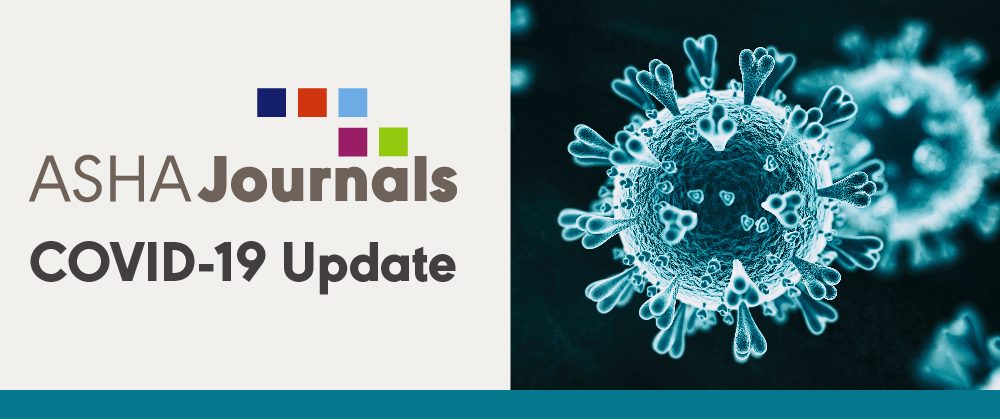Given the ongoing strain that the COVID-19 pandemic is placing on so many aspects of our daily lives and planned endeavors, we wanted to provide an update on the operations of the ASHA journals during these difficult times.
First, we want to assure authors and readers that it is our intent to continuously publish articles, as well as issues, for all five of our peer-reviewed journals during the COVID-19 pandemic. We do not anticipate any disruption to the availability or functioning of the ASHAWire platform, and our suppliers and vendors have assured us that their geographically distributed operations are well-situated to flex under any localized stresses that may be encountered.
For our print-on-demand subscribers, every effort will be made to avoid any delivery problems, but we must acknowledge that occasional delays may be experienced due to factors beyond our control. If you do experience a delay in receiving your issues, please contact subscribe@asha.org so that we are aware of that and can inquire with the printer on your behalf.
We applaud the efforts of universities, cities, states, and countries around the world to help “flatten the curve” and stop the spread of the coronavirus pandemic. However, we understand that these necessary strategies have a very real impact on the professional, academic, and personal lives of contributors to and editorial board members of the ASHA journals. For this reason, we will remain supportive by offering flexible turnaround times throughout this crisis.
Authors, reviewers, and editors can request extensions for any deadline, whether for revisions, reviews, or decisions. Regularly scheduled reminder emails will still go out, but each will contain instructions on how to extend the deadline if necessary. Anyone working in Editorial Manager can ask to have a deadline extension before they receive a reminder email by contacting their journal’s administrator at AJA@asha.org, AJSLP@asha.org, JSLHR@asha.org, LSHSS@asha.org, or Perspectives@asha.org.
If you are an author with a manuscript in review at any ASHA journal, rest assured that it is being handled as per our standard processes. The added flexibility regarding schedules may affect individual manuscript processing times, but we are closely monitoring that and will promptly let you know of any such timeline adjustments. Our workflows are designed to accommodate variability in the flow of submissions throughout any given year, so we anticipate being able to offset any incidental slowdowns that may be experienced on the way to a decision and/or publication.
If you are a student or instructor concerned about access to the journals through your library subscription, please be aware that in 2019 we completed work with Google Scholar to make available Campus Activated Subscriber Access (CASA). For libraries participating with Google Scholar, CASA allows for seamless off-campus access to an institution’s licensed content. Please contact your institution’s librarians or library administrators if you have any questions or problems with this access.
For members and affiliates of ASHA, please note that ASHA has created a landing page for a variety of updates related to COVID-19. The page, easily accessible from www.asha.org, provides information in several key areas, including public policy updates and setting-specific resources.
Because many ASHA members may be needing more background or guidance on telepractice, we have developed a special collection: Resources for Telepractice. This collection includes links to articles and other ASHA resources. All content in the collection is freely available.
We hope that these resources, as well as greater flexibility in the submission process timelines from the ASHA journals, will be useful for all ASHA members during the pandemic. We value the important work of audiology and speech-language pathology practitioners, researchers, and educators, and will continue to provide tools and resources to help you to continue this work uninterrupted.
For the latest updates on ASHA’s resources and efforts related to COVID-19, you can follow @ASHAWeb on Twitter. For the latest updates from ASHA’s journals, including new articles and previously published articles related to telepractice, please follow @ASHAJournals or @SIGPerspectives. Don’t forget to keep your eye on ASHA’s Resources for Telepractice page for the latest free articles from the ASHA Journals.
Explore the Special Collection
Alvares, R. (2013). Working with facilitators to provide school-based speech and language intervention via telepractice. Perspectives on Telepractice, 3(2), 44-48. https://doi.org/10.1044/teles3.2.44
Ben-Aharon, A. (2019). A practical guide to establishing an online speech therapy private practice. Perspectives of the ASHA Special Interest Groups, 4(4), 712-718. https://doi.org/10.1044/2019_PERS-SIG18-2018-0022
Beukes, E. W., & Manchaiah, V. (2019). Internet-based audiological interventions: An update for clinicians. Perspectives of the ASHA Special Interest Groups, 4(3), 542-552. https://doi.org/10.1044/2019_PERS-SIG18-2018-0003
Boisvert, M. K., & Hall, N. (2019). Telepractice for school-based speech and language services: A workload management strategy. Perspectives of the ASHA Special Interest Groups, 4(1), 211-216. https://doi.org/10.1044/2018_PERS-SIG18-2018-0004
Burns, C. L., & Wall, L. R. (2017). Using telepractice to support the management of head and neck cancer: Key considerations for speech-language pathology service planning, establishment, and evaluation. Perspectives of the ASHA Special Interest Groups, 2(13), 139-146. https://doi.org/10.1044/persp2.SIG13.139
Cohn, E. R., & Cason, J. (2019). Ethical considerations for client-centered telepractice. Perspectives of the ASHA Special Interest Groups, 4(4), 704-711. https://doi.org/10.1044/2019_PERS-SIG18-2019-0001
Dekhtyar, M., Braun, E. J., Billot, A., Foo, L., & Kiran, S. (2020). Videoconference administration of the Western Aphasia Battery–Revised: Feasibility and validity. American Journal of Speech-Language Pathology. Advance online publication. https://doi.org/10.1044/2019_AJSLP-19-00023
Grillo, E. (2019). Building a successful voice telepractice program. Perspectives of the ASHA Special Interest Groups, 4(1), 100-110. https://doi.org/10.1044/2018_PERS-SIG3-2018-0014
Krumm, M. (2014). Teleaudiology model considerations. Perspectives on Telepractice, 4(1), 4-10. https://doi.org/10.1044/teles4.1.4
Pullins, V., & Grogan-Johnson, S. (2017). A clinical decision making example: Implementing intensive speech sound intervention for school-age students through telepractice. Perspectives of the ASHA Special Interest Groups, 2(18), 15-26. https://doi.org/10.1044/persp2.SIG18.15
Sutherland, R., Hodge, A., Trembath, D., Drevensek, S., & Roberts, J. (2016). Overcoming barriers to using telehealth for standardized language assessments. Perspectives of the ASHA Special Interest Groups, 1(18), 41-50. https://doi.org/10.1044/persp1.SIG18.41
Tindall, L. (2013). Client safety and telepractice in a clinic or home setting. Perspectives on Telepractice, 3(2), 41-43. https://doi.org/10.1044/teles3.2.41
Weidner, K., & Lowman, J. (2019). Telepractice for adult speech-language pathology services: A systematic review. Perspectives of the ASHA Special Interest Groups, 5(1), 326-338. https://doi.org/10.1044/2019_PERSP-19-00146







